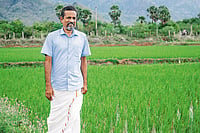Licious is India’s first D2C unicorn. Did you ever imagine achieving such astounding success?
We certainly didn’t think this big. But every time we looked ahead, we realised we are not thinking big enough. Every time we wrote a business plan, we upward revised the numbers. But our consumers made our journey easy. We never thought our customers will show that much sticky behavior.
What was the inspiration behind starting a fresh animal protein startup in such an unorganized sector?
Most meat shops in our country are anything but clean; they are dingy and unhygienic. Isn’t it surprising? It’s food after all. So, being a meat-eater myself, that bothered me from time to time. But doing something in meat was Abhay’s (Abhay Hanjura, co-founder) idea. He is a Kashmiri Pandit and often complained of not getting high-quality mutton in Bangalore. When we started planning it out, I thought meat was a small segment of grocery – a myth that got busted soon. We also understood that there were multiple problems that needed to be solved to make a difference in the sector. On one side, we had to work with the animal rearing sector, own a processing plant, and establish a cold supply chain, while on the other, the requirement of time and money, worried us. But when we actually entered the segment, we realised the problem was much bigger than we had thought it to be. So, we changed our strategy and slowed down our execution. Our original plan was to cover three cities in three years, but for the first 2.5 years, we stayed in just one part of Bangalore. We wanted to remain small and go deep and create a consumer proposition in a way that once they try us, they don’t leave us. This strategy helped us stay focused, maintain quality and gain more customers.
How was the initial response and the subsequent growth in the past six years?
Our first 500 consumers came through references. We had made it mandatory for the entire staff to get 20 people each and get them to shop on our website. The response inspired us to stick to our core principle of quality and providing a great customer experience. In the second month itself, 90% of the customers made repeat orders, and from there on they just kept coming back. Even today, 90% of our monthly business comes from repeat customers.

Abhay Hanjura (left) and Vivek Gupta founded Licious to introduce high-quality meat and sea-food in India. The duo, have slowly and steadily, made Licious a premium brand in the segment
The supply chain and cold chain are completely owned by you. How critical is that to your growth?
Super critical. In fact, our supply chain and cold chain are one of the biggest pillars for Licious. We are here today because of what we have done in the backend. We had to own our supply chain because nothing existed prior to that. There was no quality or standard. There was not a single solution for a cold chain delivery. It wasn’t by choice but by need.
How did you go about sourcing your meat and other products?
Frozen meat as a concept never really gelled with Indians. We like our food fresh, we like our meat fresh. But what’s the definition of fresh? Meat that’s cut in front of us in the dingy meat shops? It’s no less than poison because in Indian temperatures the microbial load in meat multiplies in millions. What happens globally? If we look at the West, they switched to frozen meat long back. But Asian countries such as Japan, Korea and China consume fresh meat. We spent a lot of time in Korea to understand how the meat moves so that it remains fresh.
Our next halt was at the chicken suppliers. We went with a 140-point checklist about various quality parameters and asked them to grow chicken in accordance with that. After our first round of funding, we set up a meat unit adjacent to our processing plant and built it as per our learnings from Japan and Korea. That one ton a month demand has now risen to 30 tons of chicken a day.
Your clientele has increased manifold despite your premium pricing. In a price-sensitive market like India, how have you achieved that?
Forget meat; let’s take any consumer goods category that has got branded. Atta, for example, when it got branded, started being sold at 100% premium. Same goes for oil, pulses, etc. When the conversation is taken away from the mandi price to quality, people perceive it as premium. We, consciously, have stayed away from that price war and only concentrated on the principle that we started out with – quality. Whatever extra is the premium that we are selling at, that amount gets distributed all through the supply chain. If I put back the conversation to selling chicken at market price, I will kill my own business.

How do you educate people about the nuances of high quality meat?
We stay away from giving anyone a sit-down lesson. It never works. The best way to educate is through trials. And that, in our case, starts the moment someone lands on our website or app. We offer 26 different cuts of chicken for as many varieties of dishes. That’s called recipe backward thinking. The meats are clean and don’t require repeated washing. Plus, because the meats are grown differently, they cook fast and taste better. So, it’s an entire experience that we promote.
What about innovation and R&D? Do you do consumer surveys to get it right? Do you have specialists for quality and taste?
We thrive on constant innovation. We launched the world’s first meat-based spread with actual chunks of meat after customer feedback stated that “we are bored of jams and butter, can’t you ‘meatify’ our breakfast”? Our range of ready-to-cook seekh kebabs, which are bestsellers now, took about 1.5 years to innovate. We had to ensure that the taste remains the same irrespective of who cooks it (basically, making it ‘idiot-proof cooking’). 40% of our new customers in their first order now buy a value-added product (read snacks).
There’s a 50-plus team in Licious, which is only dedicated for product-line innovation. These are food technologists and scientists, and chefs. We also have a consumer panel comprising of consumers, industry chefs and food bloggers that tastes a new product and engages with us on recipes.
Your future plans…
We have a whole range of products lined up in the ready-to-cook category. In about two months, we have plans to launch state-of-the-art experiential meat stores in Bangalore and NCR to provide a never-before experience to meat lovers.
We also have plans to launch something in alternative protein such as plant protein. It is an interesting area that is growing globally though it hasn’t penetrated India so much, yet. But if people think, vegetarians will consume plant protein, that’s not going to happen. First is, there are innumerable choices in vegetarian food in India and secondly, a vegetarian will never appreciate the taste of meat (even if its plant protein). We don’t know how it will pan out, but a separate team in Licious is working on this.
***
Upward Trend
Last FY growth 500%
YoY growth over the last 5 yrs 300%
Total no. of unique customers served till date 2 Mn+
No. of orders per month 1.5 Mn+
Revenue run rate 1,000 cr






























